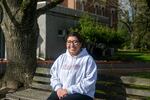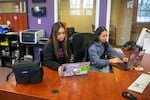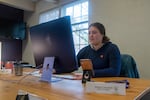Tatiana Garcia didn’t realize she needed a learning accommodation until pretty recently.
Garcia is a fourth year student at Linfield University in McMinnville, and she has a lot on her plate. Among other positions, she’s in leadership at her sorority, she works with the university’s chaplain to plan on-campus events, and she’s a residential adviser.
Garcia gets stressed out taking tests. She said she gets nervous in rooms packed with other students, and she often feels rushed to finish.
“It was actually during RA training when we were talking about, ‘Oh, you can go to Learning Support Services for accommodations,’” she said. “That’s when I realized maybe this is what I need. So, I did go there and put myself out there. I was like, ‘Listen, I don’t know what I need yet, but I definitely do know I need accommodations.’”
Garcia said by talking through her needs with Learning Support Services staff, she is now able to get extended time on her tests, and she doesn’t have to take them in a busy classroom.
“It’s easier for me because I like when there’s no one in my surroundings, because I feel like I get that anxiety of like, ‘Oh my gosh. This person is done. I need to get done quicker than usual,’” she said.
Garcia has started working at the learning support services office, where she sees firsthand students looking for assistance.
She said she feels like the pandemic has made asking for and receiving accommodations more normalized, including for one particular population: students who got sick with coronavirus.

Tatiana Garcia is a fourth-year student at Linfield. She's busy with multiple jobs, extracurriculars and of course, class. She says it was only recently she realized she needed a learning accommodation, and she says the pandemic has made asking for support feel more normal.
Meerah Powell / OPB
“The first thing you do if you get COVID is you have to reach out to learning support,” Garcia said. “It’s like, ‘Hey, I have COVID. I can’t go to class. I have an exam, so I’m going to need to retake it.’”
The pandemic upended life across the board, but it’s also forced colleges and universities to reassess how they support students facing difficulties.
At Linfield, students and employees say technology spurred by the pandemic has not only helped those in need of specific accommodations, but everyone. The pandemic forced Linfield to prioritize creating more connection and communication, and in turn students have felt more comfortable and supported through the flexibility that remote services provided. In some cases, those changes have stuck around even as everyone has returned to campus.
Pandemic made accessibility an ‘everybody issue’
“Making things inclusive should be part of design, part of curricula in the first place, and then it doesn’t always fall on offices like mine to do that,” said Jewls Griesmeyer-Krentz, Linfield’s associate director for Learning Support Services. “One of the things I really want to make sure we all understand is that it’s an ‘us’ thing, it’s not a ‘them’ thing, or ‘this office’ thing.”
Since the pandemic began, Griesmeyer-Krentz said she has seen a change in who’s responsible for supporting students with disabilities, or with other barriers to their education.
In 2020 when Linfield and other colleges and universities across Oregon had to pivot to remote learning, everyone was thrown into unfamiliar territory. Instructors had to adapt to new ways of teaching and students to new ways of learning. Administrators had to try to keep their big institutions running under all that stress.
Griesmeyer-Krentz said that was a turning point.
“All of a sudden everybody was doing something in a way that didn’t necessarily meet their needs, and so it became easier to talk about where the struggles are,” she said.

Jewls Griesmeyer-Krentz is Associate Director of Linfield's Learning Support Services. She says the pandemic has made accessibility an "everybody issue."
Courtesy of Jewls Griesmeyer-Krentz
Making school more accessible and flexible has been something people in disability services have talked about for a long time, Griesmeyer-Krentz said, but “with the pandemic, it became an ‘everybody issue’ instead of a ‘select few’ issue.”
Over that first part of the pandemic, like many other schools, Linfield ramped up its technology — and not just online classes. The college offered virtual counseling and tutoring, and encouraged students to check out laptops, if they didn’t have them. Administrators mention an ongoing proliferation of Zoom meetings, as a way to “meet students where they’re at.” All of those steps have ramped up the university’s accessibility.
Now as Linfield and other institutions get fully back into the swing of things on-campus and in-person, some of those sentiments of accessibility still remain, and many hope it’ll be a permanent shift.
Flexibility helps school-life balance
There are signs that greater flexibility and help for students have become a normal part of campus life at Linfield, even as the pandemic has less of a daily impact.
When a student gets sick, they can still go to the university’s Learning Support Services office and get help staying on track academically. It’s helped lead to healthier habits.
“With the whole spiking COVID and being sick, not a lot of us had prioritized like, ‘I can’t come to school today, because I’m sick.’ We’d still go. But I think now that Zoom is an option all the time, we’re more like, ‘OK, I need to take care of myself.’ We’re still getting things done,” said Taetum Lynn Kalani, a sophomore at Linfield.
She and another second-year student, Kami Echiverri, are the co-chairs of Linfield’s Lu’au and Ho’ike, an annual event put on by students from Hawaii and other Polynesian cultures. They’re also both part of Linfield’s program for first generation college students, First Scholars.
Kalani and Echiverri also appreciate that new technology allows them to be in two places at once — including when those two places might be more than 2,000 miles apart.

Taetum Lynn Kalani (left) and Kami Echiverri (right) are the co-chairs of Linfield’s Lu’au and Ho’ike, an annual event put on by students from Hawaii and other Polynesian cultures. The two call remote technology spurred by the pandemic "a blessing in disguise."
Meerah Powell / OPB
“A lot of people go home for certain reasons and having the opportunity to go to class over Zoom and not miss anything is a good thing, especially for us, we’re from Hawaii,” Kalani said of her and Echiverri.
The two said they’re not fans of learning and communicating remotely, but they still call it a “blessing in disguise.”
Echiverri said she’s been attending some of her professors’ office hours virtually as a way to save time and get quick questions answered.
“I found those very helpful just because sometimes the question could be really simple, so instead of walking to their office, it’s just go on the Zoom, ask the question, and then you’re like, ‘OK, cool. Thank you so much for clearing that up,’” she said.
Kalani said remote options have helped students’ school-life balance in other ways too. She said she started doing virtual therapy at Linfield, and she’s noticed more students have begun taking advantage of those services too.
“It’s a lot easier behind the screen, and same thing with office hours — you’re not as scared to ask questions as much,” she said.
Technology offers opportunity to improve student engagement
The new convenience of being multiple places at once also resonates with Emma Campbell, Linfield’s student body president. Along with student government, Campbell is busy with other activities like swimming as a student athlete and school, of course.
Campbell said Zoom has helped her stay on top of activities and events offered remotely. It’s been a great option if she wants to go to an extracurricular event, such as “pizza and politics” panels held by Linfield’s political science department — her major — but she also feels like making dinner at home or knocking some homework out on the side.
“It takes off the stress of like, ‘I have to be there then,’ you know? I have to make sure I’m presentable and put together. I have to take off my sweatpants and put my jeans back on,” she laughed. “But I think it’s been able to help students engage more in the areas they might have otherwise not been able to. In my experience, I’ve been able to kind of be in two places at once, which is really important for how much I have going on.”
Remote communication is also helping Campbell connect two different Linfields.
Campbell is now able to communicate regularly from McMinnville with her student government counterparts at Linfield’s campus in Portland, where the core of the university’s nursing program is located.
That’s not something that regularly happened before the pandemic, she said.

Emma Campbell is Linfield's student body president. She says students are feeling burnt out on Zoom and ready to get back together in-person, but remote technology still has its uses.
Meerah Powell / OPB
“We could potentially find the time like once a semester to drive to each other and see each other, but it’s probably not going to work,” Campbell said. “So Zoom is a really easy tool for us to use to just hop on and be able to communicate and keep those lines of communication open.”
Still, Campbell said many students, including herself, are tired of Zoom. The student president said getting students more engaged and back together for in-person events on campus is a big goal this year.
“In my experience, with student leaders particularly, it seems that we’re very hesitant to go back on Zoom,” Campbell, a third year student, said. “It’s not as engaging, and we want to try to bring people together as much as possible.”
Regardless, Campbell said, she knows the option for virtual communication will stick around.
Associate Director of Learning Support Services Griesmeyer-Krentz said although it’s a slow process, she’s grateful for the discussion of lowering barriers and strengthening connections. For her own work, she’s glad the pandemic has gotten the ball rolling to have more open conversations about accommodations and accessibility.
She just hopes that work continues as the height of the pandemic becomes more distant.
“I think the needle moves slowly,” she said. “[But] I guess the way to continue to do that is to continue to work together.”
